Introduction
- Asthma is one of the most common chronic respiratory diseases.
- More than 6 million American children are currently diagnosed with asthma.
- About 20 million adult patients treat asthma annually (Centers for Disease Control and Prevention, 2018).
- $100 is an approximate annual medical cost of asthma per child in the US.
Today, asthma is known as one of the most common respiratory diseases in the United States, as well as in the whole world. It affects both, children and adults, and includes a variety of symptoms from a regular cough to insomnia because of shortness of breath. The Centers for Disease Control and Prevention (2018) reports that about 6 million children and 20 million adults are currently diagnosed with asthma. It is a burning problem for the US government because it is stated that about $100 should be spent on one child’s treatment plan (Zahran, Bailey, Damon, Garbe, & Breysse, 2018). Regarding such facts and urgency of asthma issues in the American society, one should know how to develop SOAP notes and underline the most important information.
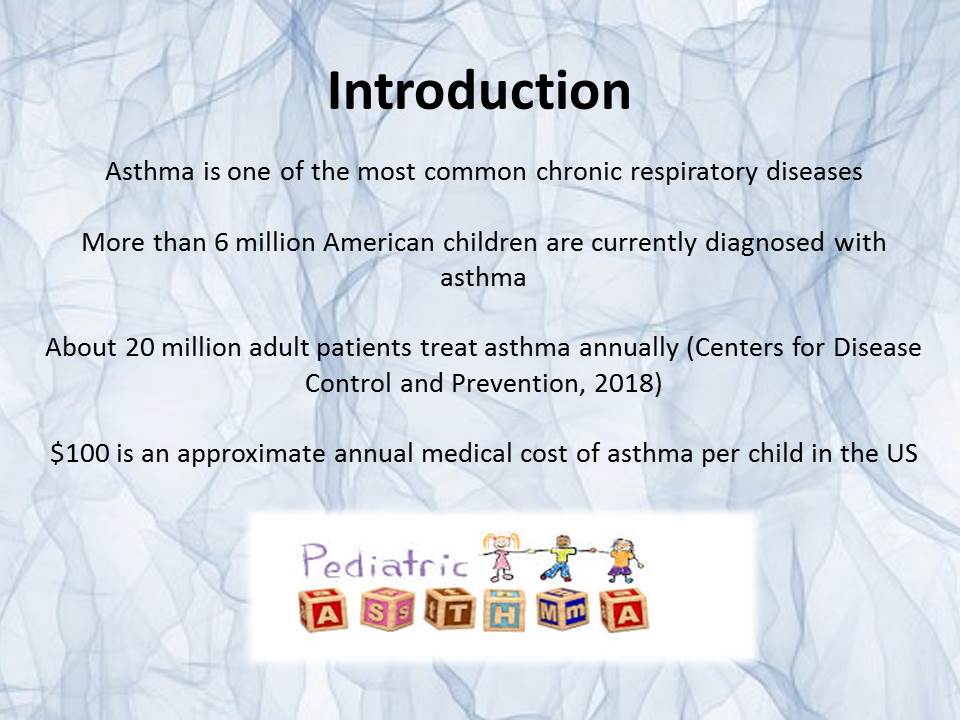
Case Presentation
Patient: Kelly, a 10-year-old white girl.
CC: “I feel it is difficult for me to breathe in deeply when I play with my friends.”
HPI: The girl’s mother started worrying about her breathing complaints three days ago. Kelly feels pain from time to time and cannot play with her friends all the time she wants. No medications are taken.
PMH: No surgeries, no allergies. Pneumonia at the age of 4.
Social history: She lives with her parents. The father is a smoker.
The patient is delivered to the hospital by her mother. Kelly is a 10-year-old white girl who admits that she cannot easily breathe when she plays with her friends and run outside. Her mother observed these health changes three days ago but did not decide to take some medications. The girl was treated for pneumonia six years ago. No surgeries neither allergies are reported by the mother. In their family, the father is a regular smoker. Smoking is one of the risk factors of asthma for patients (Ierodiakonou et al., 2016). Therefore, the girl could be exposed to indirect smoking even unintentionally.
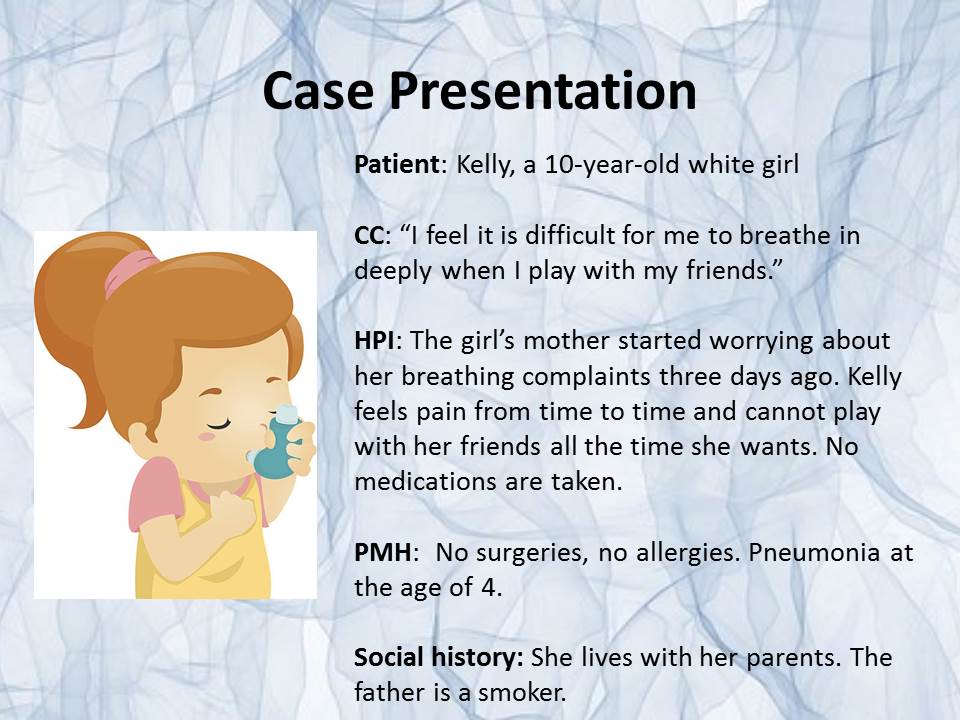
Review of Systems (ROS)
- General: No chills, night sweats, or migraines. Fatigue and fear.
- HEENT: No complaints.
- Gastrointestinal: Abdominal pain once at night.
- Genitourinary: No complaints.
- Respiratory: Chest pain and a dry cough after extensive running.
- Neurological: No complaints.
The review of systems helps to recognize the main health problems and changes. The patient has a good general look. She denies chills, night sweats, and migraines. Still, she, as well as her mother, says that fatigue starts bothering you from time to time. At the same time, it is evident that the girl experiences fear because of the inability to understand what happens. No complaints are reported on HEENT, the genitourinary system, and the neurological field. Abdominal pain bothered her once at night before this visit. Chest pain and a dry cough were observed several times during the last week after long runs with her friends.
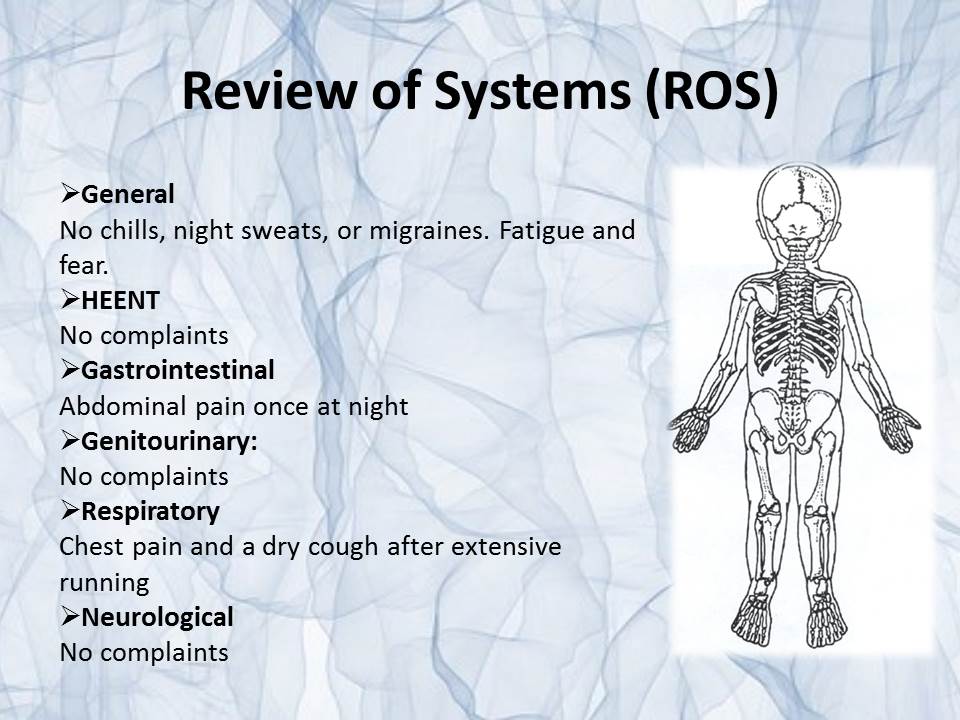
Physical Examination
Vital Signs: BP: 110/70, P: 90, RR: 30, T: 97.5, height: 55”, weight: 70 lbs.
General: The patient looks calm but constrained. She is eager to talk but feels that something wrong.
HEENT: Normal, without deviations.
Gastrointestinal: Symmetrical abdomen without distention, normal bowel sounds.
Respiratory: Wheezing (not frequent).
A physical examination of a patient is developed in a good manner. The child sits still and makes the physical examination possible from different perspectives. All vital signs, including blood pressure, pulse, respiratory rate, temperature, meet the norm. In general the patient looks calm, but a portion of fear cannot be ignored because of the girl’s fear that her health is not ok. She like talking and shares her thoughts about her condition openly. NEENT findings are normal, but respiratory findings prove wheezing and chest pain that turn out to be the main early signs of asthma in children (Zahran et al., 2018). Gastrointestinal examination does not define any changes or complications in the patient.
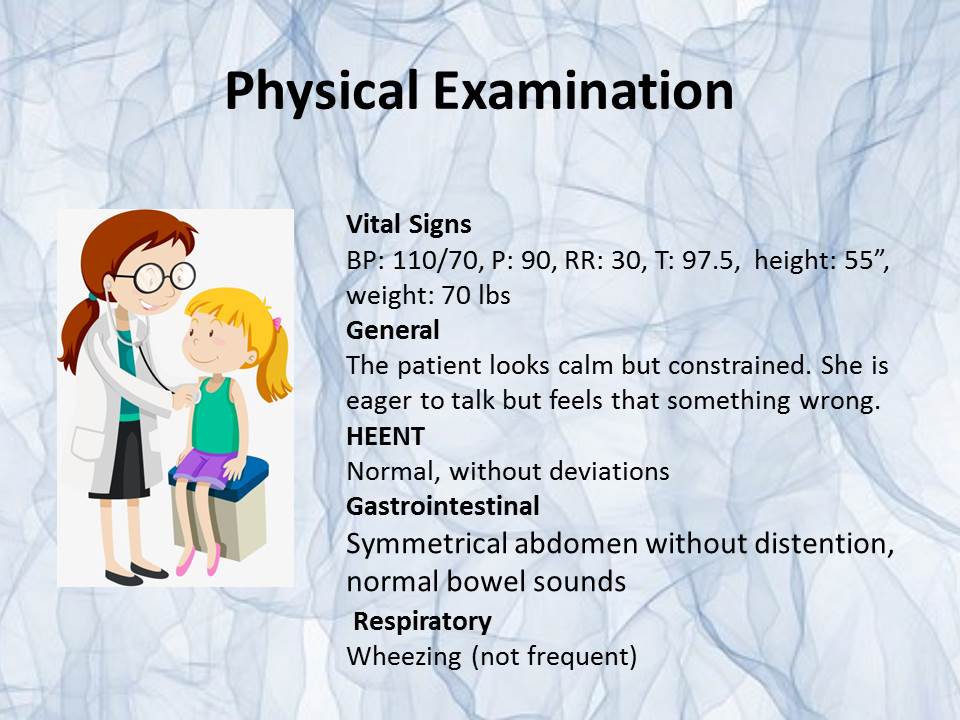
Differential Diagnoses
- Congestive heart failure, unspecified (ICD-10: I50.9).
- Chronic obstructive pulmonary disease, unspecified (ICD-10: J44.9).
- Gastroesophageal reflux without esophagitis (ICD-10: K21.9).
Regarding the signs and symptoms, as well as the age of the patients and the fact of her exposure to passive smoking, the following differential diagnoses can be given:
- Congestive heart failure (CHF) (the reduction of lung compliance may lead to dyspnea and wheezing in a child);
- Chronic obstructive pulmonary disease (COPD) (cough and wheezing because of passive smoking may be the dangerous signs for the patient even at her young age);
- Gastroesophageal reflux (GER) (a cough and wheezing along with the patient’s history of pneumonia at the age of 4 may be associated with GER).
All these diagnoses may be excluded after several laboratory tests and examinations are developed:
- GER (exclude gastric juice);
- CHF (exclude blood pressure changes);
- COPD(exclude emphysema).
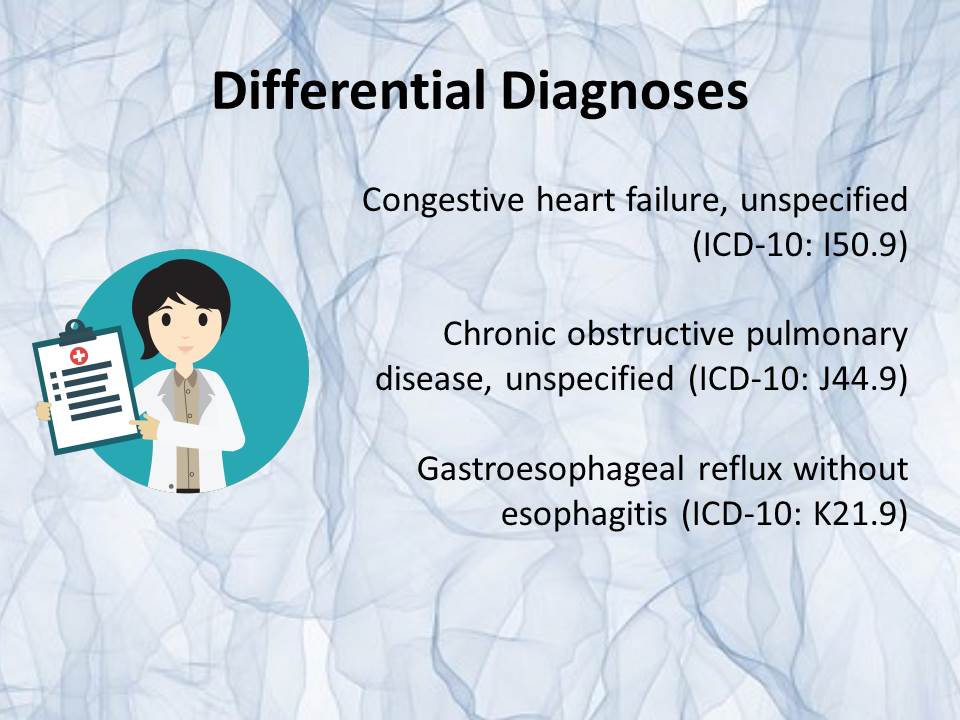
Labs and Tests
- Peak flow;
- Spirometry;
- Chest X-ray;
- Challenge tests:
- methacholine challenge;
- nitric oxide test;
- allergy test.
The main goal of any laboratory tests is to check the condition of the patient’s lungs. A peak flow meter can be used to check how hard a child may breathe. Low flows prove that some problems in the lungs occur. Spirometry is another important tool to check the condition of bronchial tubes and the volumes of air that could be breathed in (Ierodiakonou et al., 2016). Chest X-rays aim at detecting lung abnormalities that lead to breathing problems. There are also several challenge tests that may be additionally assigned to the patient:
- Methacholine challenge (when methacholine is breathed in, it causes numerous constrictions which prove the patient has asthma);
- Nitric oxide test (this gas determines the level of inflammation that may occur in the airways);
- Allergy test (blood tests can be used to identify if the patient has specific reactions to irritants that may cause a cough or wheezing).
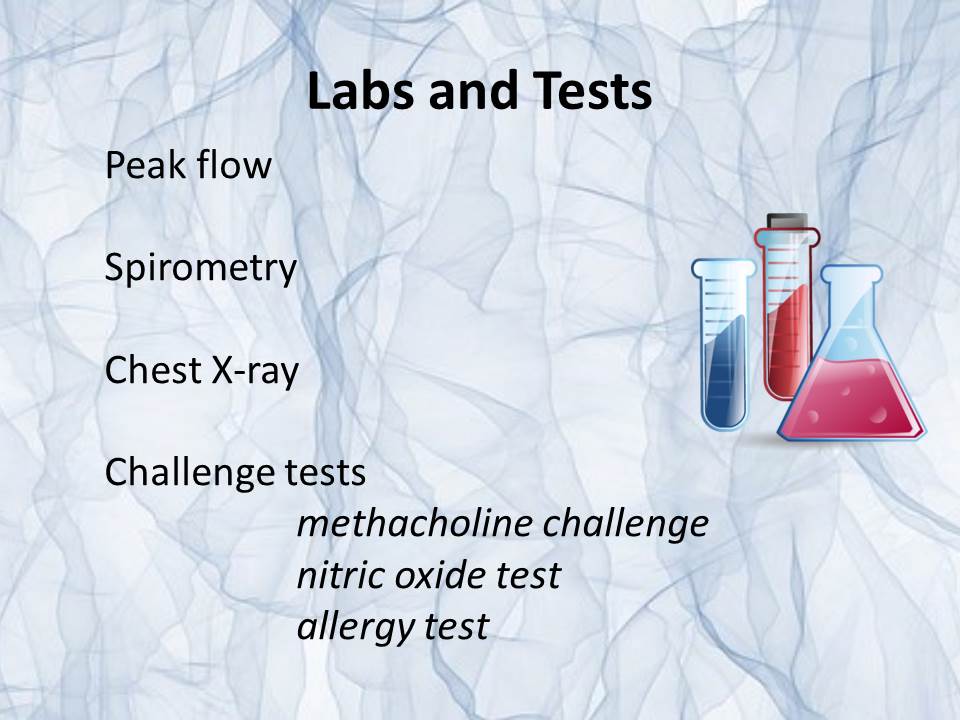
Medications
- Inhaled corticosteroids: (Fluticasone or Budesonide);
- Combination inhalers: (Advair or Symbicort);
- Leukotriene modifiers: (Montelukast or Zileuton);
- Theophylline: (Elixophyllin).
Treatment that can be offered to asthmatic patients, including children, is based on the necessity to prevent and control attacks before they start. It is necessary to remember that asthma can hardly be cured, and the task of medications is to reduce associated symptoms. Some medications may be taken seasonally to reduce the risks of allergy, and some drugs should be used on a long-term basis in order to control asthmatic attacks.
- Inhaled corticosteroids (to reduce oxidative stress and improve airway functions) (Ierodiakonou et al., 2016).
- Combination inhalers (to reduce and control the number of severe asthma attacks) (Buelo et al., 2018).
- Leukotriene modifiers (to control asthma symptoms in a short period of time and reduce the risks of unpredictable attacks).
- Theophylline (to open airways).
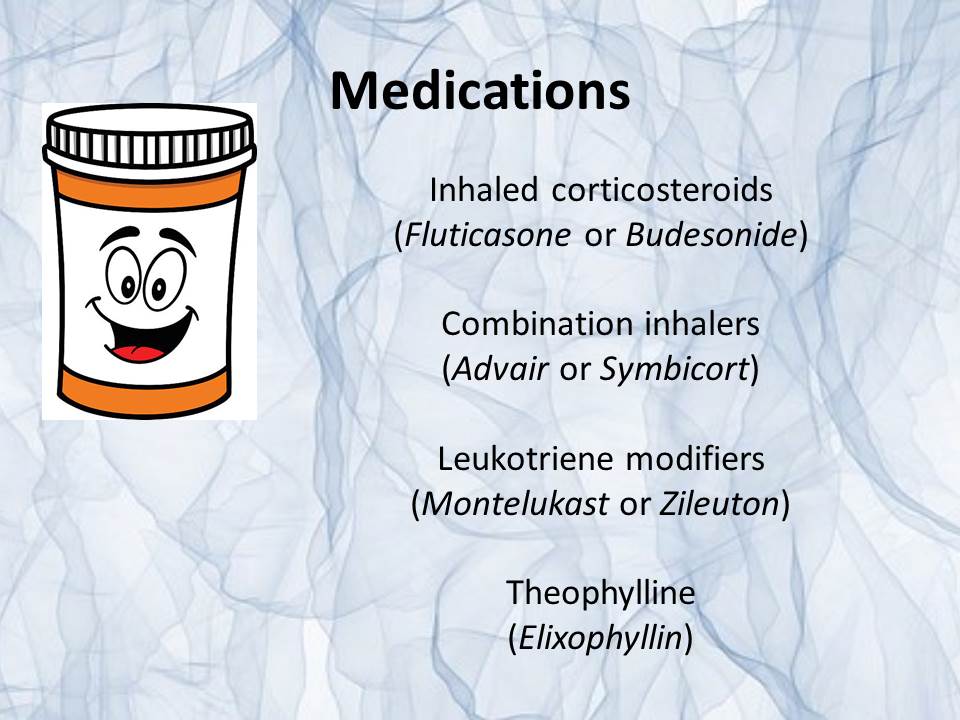
Outcomes for Asthmatic Patients
- Reduced exposure to a harmful environment;
- Decreased number of unplanned visits to the ED;
- No missed days at school because of asthma;
- Control of severe asthma attacks.
In case of appropriate treatment, certain expected and unexpected outcomes for asthma may be observed:
- The reduction of exposure to a harmful environment;
- The decrease in unplanned visits to the ED;
- Zero missed classes because of unpredictable asthma attacks;
- The possibility to control or avoid severe asthma attacks.
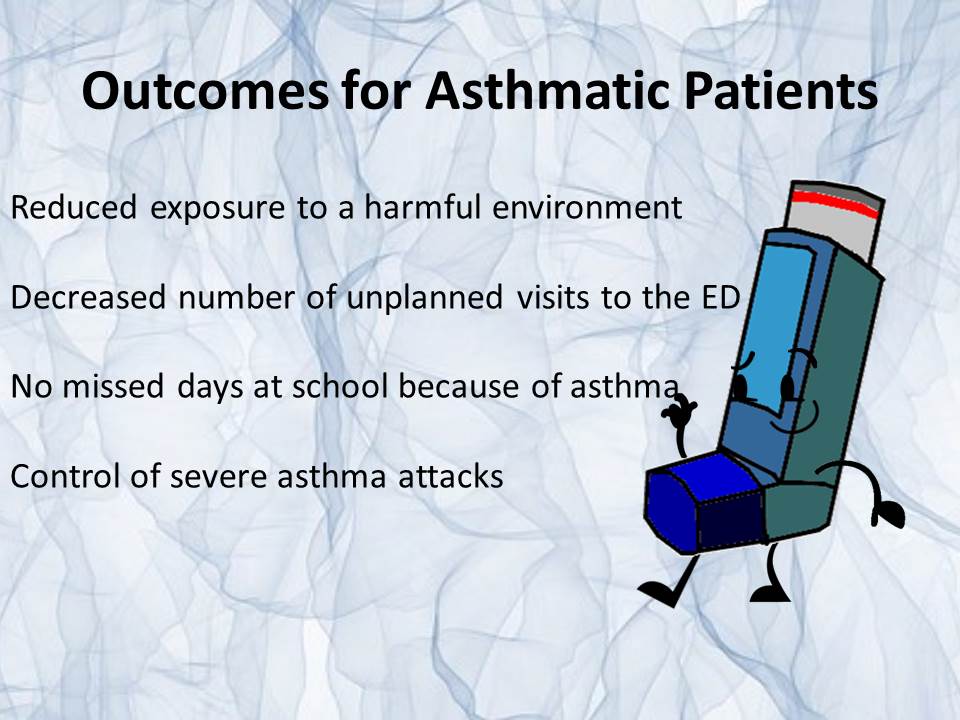
Patient Education
- Understand the diagnosis;
- Impact on everyday activities;
- Importance of inhalers;
- Control of attacks;
- Ask for emergent help.
Patient education plays an important role in asthma treatment. Children, as well as their parents, should know how to behave during asthma attacks and how to avoid the situations that can worsen this condition. As a part of educations, it is recommended for patients and their families to:
- Gain a better understanding of the diagnosis and take tests regularly;
- Realize that asthma determine certain human activities;
- Comprehend the worth of inhalers and always have at least one nearby (Ehteshami-Afshar & FitzGerald, 2017);
- Recognize the possibilities to control asthma attacks and avoid unsafe environments;
- Never be afraid to ask for help.
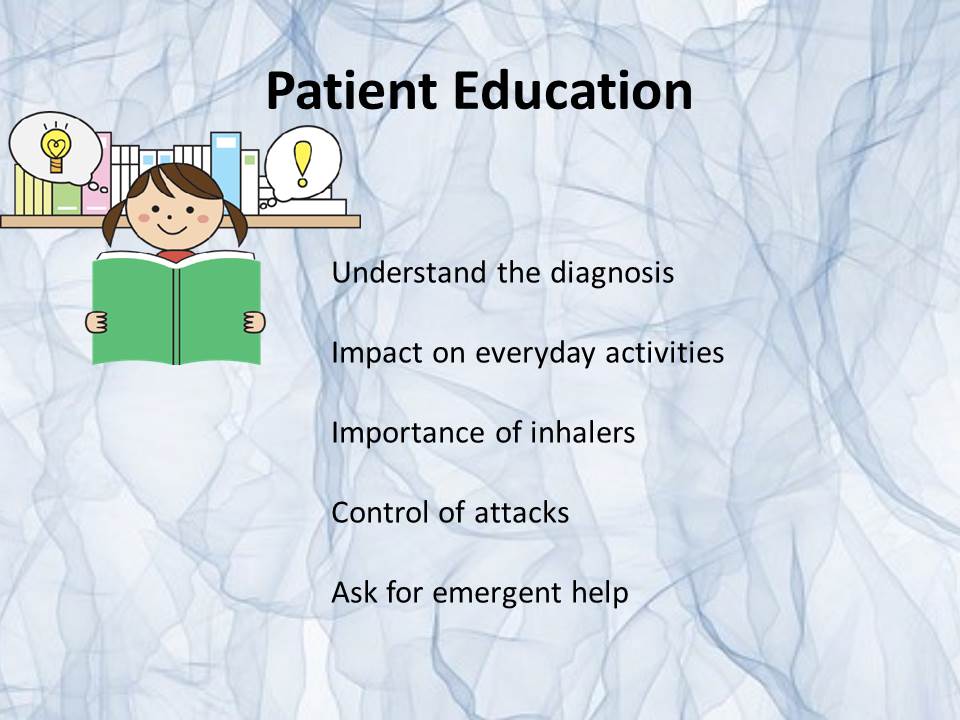
Conclusion
- Asthma cannot be cured but can be controlled;
- Children should ask their parents for help;
- Inhalers must be at hand;
- Medical control is important.
In general, the analysis of this SOAP note on asthma shows that this condition may be dangerous for unprepared patients. It is important to understand that this disease cannot be cured, and people should learn how to live with it and control attacks. Children are in need of additional help and support from their parents. The main rule is to never forget about inhalers and ask for medical assistance anytime. Nurses and therapists are eager to educate children and help their parents or caregivers understand the basics of the life with asthma.
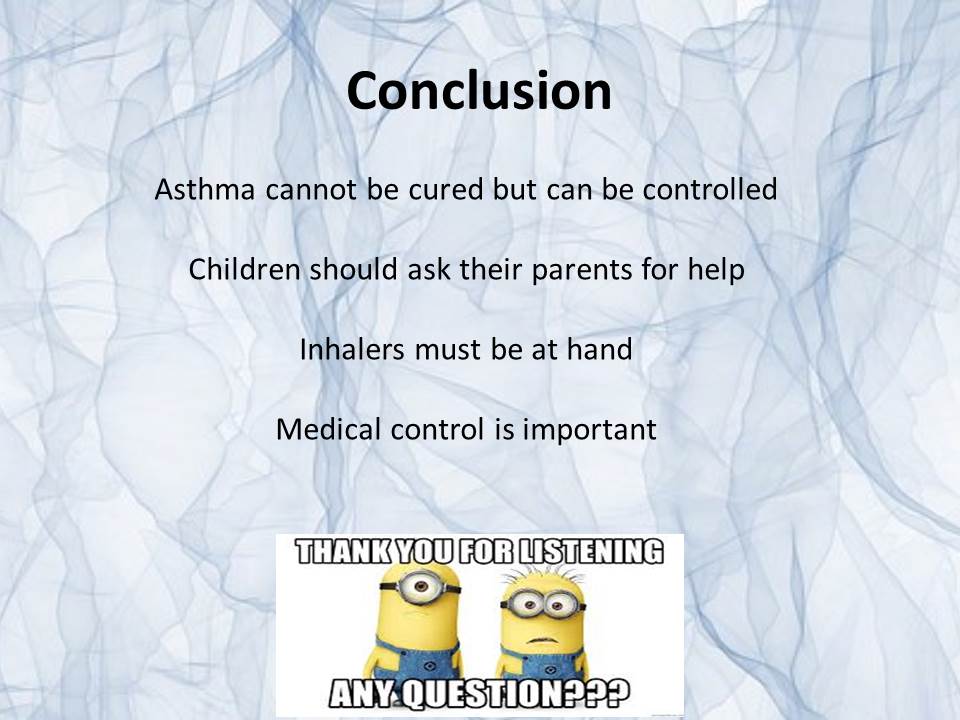
References
Buelo, A., McLean, S., Julious, S., Flores-Kim, J., Bush, A., Henderson, J., … Pinnock, H. (2018). At-risk children with asthma (ARC): A systematic review. Thorax, 73(9), 813–824.
Centers for Disease Control and Prevention. (2018). Most recent asthma data. Web.
Ehteshami-Afshar, S., & FitzGerald, J. M. (2017). Asthma patient education, the overlooked aspect of disease management. Canadian Journal of Respiratory, Critical Care, and Sleep Medicine, 1(1), 43–45.
Ierodiakonou, D., Zanobetti, A., Coull, B. A., Melly, S., Postma, D. S., Boezen, H. M., … Gold, D. R. (2016). Ambient air pollution, lung function, and airway responsiveness in asthmatic children. Journal of Allergy and Clinical Immunology, 137(2), 390–399.
Zahran, H. S., Bailey, C. M., Damon, S. A., Garbe, P. L., & Breysse, P. N. (2018). Vital signs: Asthma in children – United States, 2001–2016. MMWR Morbidity and Mortality Weekly Report, 67(5), 149–155.